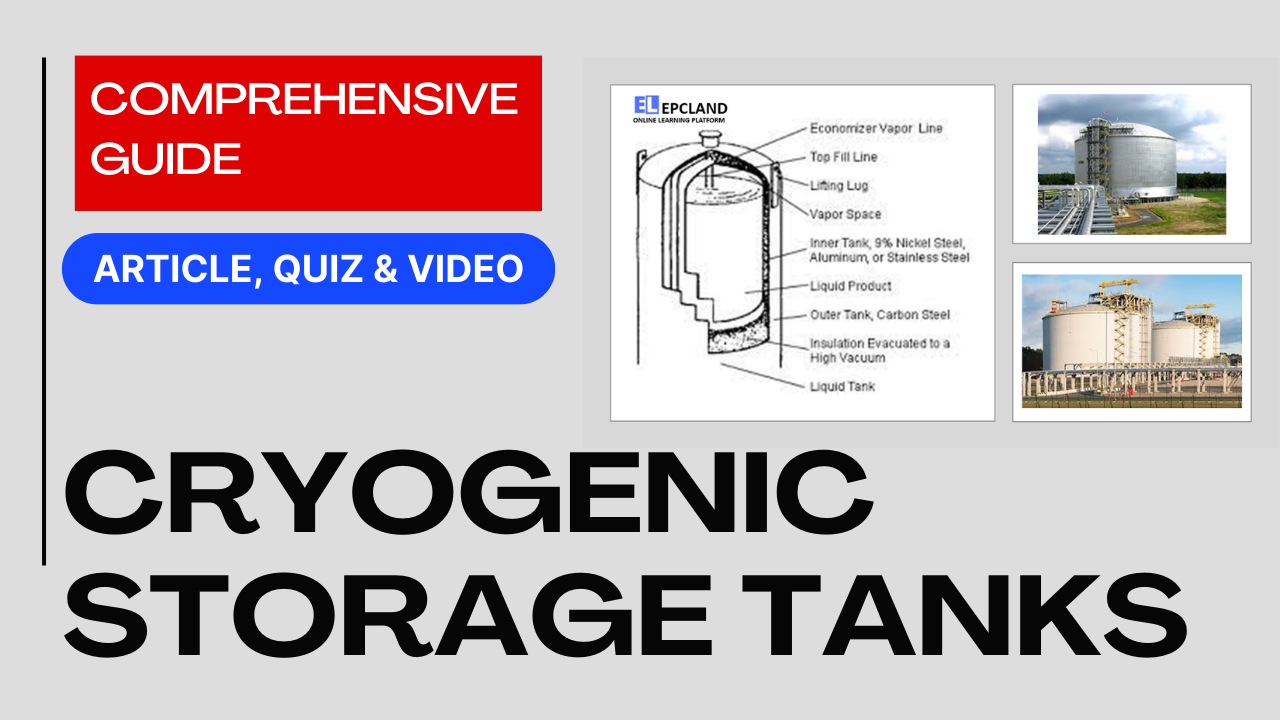Introduction to Cryogenic Storage Tanks
Cryogenic storage tanks are a critical component of industries that require the safe and efficient storage of gases and liquids at extremely low temperatures. These tanks play a pivotal role in sectors ranging from energy and healthcare to aerospace and scientific research. By maintaining substances in their cryogenic states, these tanks enable the storage and transportation of materials that would otherwise be challenging or impossible due to their low boiling points. In this comprehensive article, we delve into the principles, design considerations, types, operations, safety measures, and future trends of cryogenic storage tanks.
Table of Contents
Do not miss the detailed course on Tank Farm Layout & Stress Analysis
Enrollment link
Check out Similar Articles on other Storage Tanks
Principles of Cryogenics
Cryogenics, derived from the Greek word “kryos” meaning cold, is the science of studying and working with materials at temperatures well below those found in natural environments. The behavior of gases at cryogenic temperatures defies common intuition; they can transform from gaseous to liquid or even solid states. This extreme cold, often below -150°C (-238°F), necessitates specialized storage and handling to prevent evaporation, leaks, and pressure build-up. Cryogenic fluids have diverse applications, including medical procedures, rocket propellants, and liquefied natural gas (LNG) for energy production.

Design and Construction of Cryogenic Storage Tanks
Materials and Insulation
Cryogenic storage tanks are constructed using materials with exceptional thermal properties to withstand the extreme cold and maintain the low temperatures of their contents. Common materials include stainless steel, aluminum, and nickel alloys due to their resistance to embrittlement at low temperatures. To minimize heat transfer and preserve the stored substances’ frigid state, these tanks are equipped with high-efficiency insulation materials, such as perlite, aerogel, and vacuum-insulated panels.
Double-Walled vs. Single-Walled Tanks
Cryogenic storage tanks are often designed with either single-walled or double-walled configurations. Single-walled tanks are simpler in design and construction, but they may have limitations in terms of heat transfer prevention and safety in case of leaks. Double-walled tanks, on the other hand, offer an additional layer of protection by creating a vacuum space between the inner and outer walls, reducing heat transfer and minimizing the risk of cryogenic fluid release.
Safety Features and Considerations
Safety is of paramount importance when dealing with cryogenic fluids. Pressure relief systems are integral components, ensuring that pressure doesn’t build up excessively within the tank. These systems release excess pressure through controlled vents. Leak detection and prevention mechanisms are also essential to avoid hazardous situations. Advanced sensors are used to monitor any leaks, triggering alarms and shutdown procedures if necessary.
Table 1: Tank Components
| Component | Function |
|---|---|
| Inner Tank | Contains the cryogenic fluid |
| Outer Tank | Provides additional insulation and protection |
| Vacuum Space | Reduces heat transfer between inner and outer walls |
| Pressure Relief Valve | Prevents over-pressurization of the tank |
| Leak Detection System | Monitors for leaks and triggers alarms |
Do not miss the detailed course on Tank Farm Layout & Stress Analysis
Enrollment link
Types of Cryogenic Storage Tanks
LNG Storage Tanks
Liquefied Natural Gas (LNG) has gained prominence as a cleaner alternative to traditional fossil fuels. LNG storage tanks are crucial for storing and transporting natural gas in its liquid state, reducing its volume and enabling efficient transportation. These tanks are designed to handle the extreme cold and low temperatures of LNG, often reaching below -160°C (-256°F). While LNG tanks are generally double-walled for safety, they require specialized materials and insulation due to the specific characteristics of natural gas.
Liquefied Oxygen, Nitrogen, and Argon Storage Tanks
Cryogenic storage isn’t limited to energy applications. Tanks designed for storing liquefied oxygen, nitrogen, and argon find extensive use in medical, industrial, and scientific fields. Oxygen, for instance, is stored cryogenically for medical procedures and respiratory therapies. These tanks face challenges in maintaining the low temperatures of their contents, as oxygen and nitrogen have boiling points as low as -183°C (-297°F) and -196°C (-321°F), respectively.
Hydrogen Storage Tanks
With the growing emphasis on renewable energy, hydrogen is gaining attention as a clean energy carrier. Cryogenic storage of hydrogen is essential to keep it in a compact state, as hydrogen’s volumetric energy density increases significantly when liquefied. These tanks are designed to endure the low temperatures and high pressures required for hydrogen storage, making use of advanced materials and safety measures.

Cryogenic Storage Tank Operations and Maintenance
Filling and Emptying Procedures
Filling cryogenic storage tanks involves careful handling of the fluids to prevent excessive vaporization and pressure buildup. Cryogenic fluids are often transferred using specialized transfer lines that pre-cool the incoming fluid and minimize heat transfer. During emptying, the vaporization of the stored fluid can lead to pressure increases, which must be managed through pressure relief systems.
Inspection and Maintenance Routines
Regular inspection and maintenance are vital to ensure the structural integrity and safety of cryogenic storage tanks. Corrosion, even at low temperatures, can compromise the tank’s integrity, leading to leaks or failures. Non-destructive testing (NDT) techniques, such as ultrasonic testing and radiography, are employed to identify defects without damaging the tank.
Do not miss the detailed course on Tank Farm Layout & Stress Analysis
Enrollment link
Safety Measures and Risk Mitigation
Risk Factors
Cryogenic storage presents various risks, including pressure buildup, leaks, and fire hazards. The extremely low temperatures can also pose risks to personnel, requiring appropriate training and protective gear. Additionally, the release of cryogenic fluids into the environment can have adverse effects, making containment and proper handling crucial.
Emergency Response Protocols
In the event of a leak or spill, well-defined emergency response protocols are essential to mitigate potential hazards. Evacuation procedures, containment strategies, and communication plans must be in place to protect personnel and the environment. Fire hazards resulting from cryogenic fluid releases require specialized firefighting techniques that consider the unique characteristics of these substances.
Innovative Trends in Cryogenic Storage
Advanced Insulation Materials and Techniques
Ongoing research focuses on developing advanced insulation materials and techniques to improve the efficiency of cryogenic storage. Nanomaterials and composite insulation systems aim to further reduce heat transfer and improve the overall performance of cryogenic storage tanks.
Digitalization and Remote Monitoring
Advancements in digital technology have led to the implementation of remote monitoring systems for cryogenic storage tanks. Sensors and real-time data analysis allow operators to monitor parameters such as temperature, pressure, and leak detection from a distance, enhancing operational safety and efficiency.
Modular and Scalable Designs
Modular cryogenic storage tank designs enable flexibility in capacity and application. These systems can be easily expanded or reduced in size based on demand, providing a cost-effective solution for industries with fluctuating storage needs.
Environmental and Economic Considerations
Energy Efficiency
Efficiency in cryogenic fluid production and storage is critical for minimizing energy consumption. Improved insulation and transfer mechanisms contribute to reduced energy losses during storage and transportation, making cryogenic systems more environmentally friendly.
Environmental Impact
The release of cryogenic fluids can lead to localized cooling effects and potential harm to the environment. Strategies to mitigate these impacts include proper containment and management of leaks, as well as careful consideration of storage locations.
Economic Feasibility
The economic feasibility of cryogenic storage solutions varies based on factors such as material costs, energy consumption, and regulatory requirements. In some cases, the cost savings achieved through efficient storage and transportation can outweigh the initial investment.
Codes and Standards in Cryogenic Storage Tank Design
The design, manufacturing, and operation of cryogenic storage tanks are governed by a range of internationally recognized codes and standards. These guidelines ensure the safety, quality, and reliability of these specialized containers that handle substances at extremely low temperatures. Compliance with these codes is essential to minimize risks and prevent accidents.
Several key codes and standards pertain to different aspects of cryogenic storage tank design, construction, and operation. These include:
Table 2: Codes and Standards for Cryogenic Storage Tanks
| Code/Standard | Focus |
|---|---|
| ASME B&PV Code Section VIII | Design principles for pressure vessels, including cryogenic tanks |
| API 620 | Design and construction of large welded low-pressure storage tanks |
| API 625 | Tank systems for refrigerated liquefied gas storage |
| NFPA 55 | Storage, use, and handling of gases in cryogenic systems |
| ISO 13458 | Cryogenic vessels – Safety devices for protection against excessive pressure |
| EN 13445 | Unfired pressure vessels, including cryogenic storage vessels |
| AISC 360 | Structural design of steel elements used in cryogenic tanks |
These codes provide comprehensive guidelines for various aspects, including design principles, materials, construction, safety devices, and structural considerations. Adhering to these codes and standards ensures that cryogenic storage tanks are built to withstand the unique challenges posed by extremely low temperatures and the potential hazards associated with cryogenic fluids.
Do not miss the detailed course on Tank Farm Layout & Stress Analysis
Enrollment link
Comparison with Other Types of Storage
Cryogenic storage offers unique advantages compared to other storage methods. Its ability to store large volumes of gases and liquids in compact states makes it indispensable for applications where space is limited. Additionally, cryogenic storage minimizes the need for high-pressure systems, reducing associated risks.
Table 3: Pros and Cons of Cryogenic Storage
| Pros | Cons |
|---|---|
| Efficient storage of large volumes | High initial construction costs |
| Compact storage for gases and liquids | Energy-intensive cooling and insulation |
| Reduced risk of high-pressure systems | Potential for leaks and environmental impact |
| Versatility across industries | Safety concerns due to extreme cold |
Table 4: Comparison of Single-Walled and Double-Walled Tanks
| Aspect | Single-Walled Tanks | Double-Walled Tanks |
|---|---|---|
| Heat Transfer Prevention | Less effective insulation | Better insulation due to vacuum space |
| Leak Safety | Limited safety in case of leaks | Added protection against leaks |
| Construction Complexity | Simpler design and construction | More complex design and assembly |
| Thermal Efficiency | Lower efficiency in heat preservation | Higher efficiency in heat preservation |
Leading Manufacturers of Cryogenic Tanks
Renowned manufacturers produce top-tier cryogenic tanks that offer reliability and exceptional quality. Here is a list of well-established cryogenic tank manufacturers that have garnered trust and recognition across industries:
Table 5: Cryogenic Tank Manufacturers
| Manufacturer | Expertise and Offerings |
|---|---|
| Chart Industries | Global leader in cryogenic solutions, offering various storage and transportation options, known for innovation and extensive industry experience. |
| Air Products and Chemicals, Inc. | Multinational corporation specializing in cryogenic storage and transport solutions for diverse applications. Recognized for safety and commitment to quality. |
| Linde plc | Global industrial gases and engineering leader, providing comprehensive cryogenic equipment and services tailored to specific industry needs. |
| Taylor-Wharton | Renowned for its cryogenic tanks, including bulk storage and transportable containers, prioritizing quality and innovation. |
| Cryofab, Inc. | Design and manufacturing expert offering customized cryogenic solutions for medical, research, and industrial sectors, celebrated for quality craftsmanship. |
| Praxair, Inc. (Now part of Linde plc) | Leading supplier of industrial gases and technology, offering cryogenic storage solutions with a strong reputation for reliability and customer satisfaction. |
Do not miss the detailed course on Tank Farm Layout & Stress Analysis
Enrollment link
Cryogenic Tank Cost Factors
The cost of cryogenic tanks varies widely and is influenced by several factors, including tank size, capacity, material composition, design specifications, and additional features tailored for specific applications. Regional and market conditions also impact pricing. While precise cost figures require detailed specifics, here are approximate price ranges for various types of cryogenic tanks:
Table 6: Cryogenic Tank Cost Ranges
| Tank Type | Price Range |
|---|---|
| Small Cryogenic Dewars | $200 – $5,000 |
| Cryogenic Cylinders | $3,000 – $20,000+ |
| Bulk Storage Tanks | $10,000 – $500,000+ |
For small cryogenic dewars, portable containers with capacities ranging from a few liters to a few hundred liters, prices span from $200 to $5,000. Cryogenic cylinders, which serve industrial and medical purposes with larger capacities, range in price from $3,000 to over $20,000, depending on size and material. Bulk storage tanks, designed for large-scale storage and distribution of liquefied gases, span a wide cost spectrum from $10,000 to over $500,000. Factors such as storage capacity, construction materials, insulation type, and additional features significantly influence the price of bulk storage tanks.
Future Outlook for Cryogenic Storage Tanks
Technological Advancements
Continued research into advanced materials, insulation, and safety systems will likely lead to more efficient and cost-effective cryogenic storage solutions. Nanotechnology and innovative insulating materials hold the potential to revolutionize the field.
Emerging Industries
As industries such as renewable energy and space exploration expand, the demand for cryogenic storage is expected to rise. Hydrogen storage for fuel cells, for instance, will become increasingly crucial for transitioning to clean energy sources.
Sustainability and Regulation
The focus on sustainability will drive the development of cryogenic storage solutions that minimize energy consumption and environmental impact. Stricter regulations and standards will also play a role in shaping the design and operation of cryogenic storage tanks.
Conclusion
Cryogenic storage tanks have transcended their role as mere containers, becoming essential enablers of industries that rely on the unique properties of extremely low temperatures. Their design, operation, safety measures, and future potential are areas of ongoing innovation and development. As industries evolve and the need for efficient, compact, and safe storage solutions grows, cryogenic storage tanks will continue to shape the way we handle and utilize a wide range of substances across diverse sectors.
Frequently Asked Questions (FAQs) about Cryogenic Storage Tanks
1. What are cryogenic storage tanks used for?
Cryogenic storage tanks are used to store gases and liquids at extremely low temperatures, often below -150°C (-238°F). These tanks enable the safe storage and transportation of substances that would otherwise be challenging due to their low boiling points. They find applications in various industries, including energy, healthcare, aerospace, and research.
2. What are the main safety considerations when dealing with cryogenic storage tanks?
Safety is paramount when handling cryogenic fluids. Pressure relief systems are crucial to prevent excessive pressure buildup within the tank. Leak detection systems and emergency response protocols are in place to address potential leaks. Additionally, proper training, protective gear, and specialized firefighting techniques are essential to ensure personnel safety.
3. What is the difference between single-walled and double-walled cryogenic storage tanks?
Single-walled tanks have a simpler design but may provide less effective insulation and safety in case of leaks. Double-walled tanks feature an additional vacuum space between inner and outer walls, improving insulation and reducing heat transfer. This design enhances safety by minimizing the risk of cryogenic fluid release in case of a leak.
4. What are some of the leading manufacturers of cryogenic tanks?
Notable cryogenic tank manufacturers include Chart Industries, Air Products and Chemicals, Linde plc, Taylor-Wharton, Cryofab, Inc., and Praxair, Inc. (now part of Linde plc). These manufacturers offer a wide range of cryogenic storage solutions catering to various industries and applications.
5. What factors influence the cost of cryogenic tanks?
The cost of cryogenic tanks is influenced by factors such as tank size, capacity, material composition, design specifications, and additional features. Market conditions and regional factors also play a role in determining pricing. Small cryogenic dewars can range from $200 to $5,000, cryogenic cylinders from $3,000 to over $20,000, and bulk storage tanks from $10,000 to over $500,000, depending on the type and size.
Recommended courses (Published on EPCLand)
- Basics of Piping Engineering
- Piping Layout Engineering
- Piping Material Engineering
- Piping Stress Analysis
- Complete Course on Piping Engineering
- Material Requisitions
- Piping Material Specifications
- Valve Material Specifications
Don’t miss the published articles on following:
Related Video
Attempt Quiz
Question 1:
What is the primary purpose of cryogenic storage tanks?
Explanation: The primary purpose of cryogenic storage tanks is the safe and efficient storage of cryogenic liquids, such as liquefied natural gas (LNG), liquid oxygen, liquid nitrogen, and liquid hydrogen.
Question 2:
What temperature range do cryogenic storage tanks typically operate in?
Explanation: Cryogenic storage tanks typically operate in the temperature range of -273°C to -196°C (-459.67°F to -320.44°F), which is the range of temperatures associated with cryogenic liquids.
Question 3:
Which type of insulation is commonly used in cryogenic storage tanks?
Explanation: Vacuum insulation is commonly used in cryogenic storage tanks. It involves creating a vacuum layer between the inner and outer walls of the tank to minimize heat transfer and maintain low temperatures.
Question 4:
What is the primary material used for constructing cryogenic storage tanks?
Explanation: Stainless steel is the primary material used for constructing cryogenic storage tanks due to its durability, corrosion resistance, and suitability for low-temperature environments.
Question 5:
Which of the following gases is commonly stored in cryogenic storage tanks?
Explanation: Oxygen gas (O2), along with other cryogenic gases like nitrogen (N2) and argon (Ar), is commonly stored in cryogenic storage tanks. These tanks are also used to store liquefied natural gas (LNG) and other cryogenic liquids.



